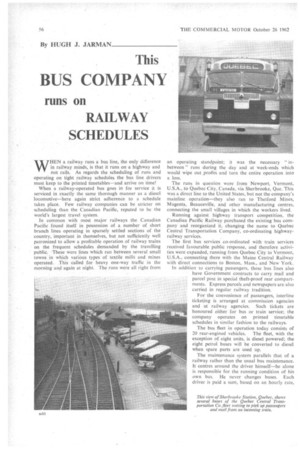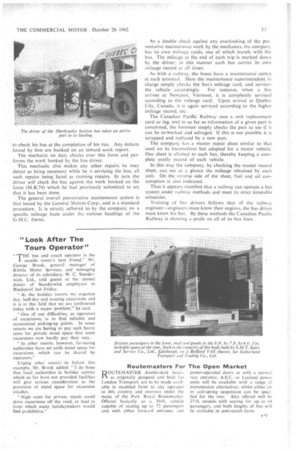This
Page 58

Page 59

If you've noticed an error in this article please click here to report it so we can fix it.
BUS COMPANY
runs on RAILWAY SCHEDULES
WHEN a railway runs a bus line, the only difference in railway minds, is that it runs on a highway and not rails. As regards the scheduling of runs and operating on tight railway schedules the bus line drivers must keep to the printed timetables—and arrive on time!
When a railway-operated bus goes in for service it is serviced in exactly the same thorough manner as a diesel locomotive—here again strict adherence to a schedule takes place. Few railway companies can be stricter on scheduling than the Canadian Pacific, reputed to be the world's largest travel system.
In common with most major railways the Canadian Pacific found itself in possession of a . number of short branch lines operating in sparsely settled sections of the country, important in themselves, but not sufficiently well patronized to allow a profitable operation of railway trains on the frequent schedules demanded by the travelling public. These were lines which ran between several small towns in which variOus types of textile mills and mines operated. This called for heavy one-way traffic in the morning and again at night. The runs were all right from an operating standpoint; it was the necessary " inbetween" runs during the day and at week-ends which would wipe out „profits and turn the entire operation into a loss.
The runs in question were from Newport, Vermont, U.S.A., to Quebec City, Canada, via Sherbrooke, Que. This was a direct line to the United States, but not the company's mainline operation—they also ran to Thetford Mines, Magenta, Beauceville, and other manufacturing centres, connecting the small villages in which the workers lived.
Running against highway transport competition, the Canadian Pacific Railway purchased the existing bus company and reorganized it, changing the name to Quebec Central Transportation Company, co-ordinating highwayrailway services.
The first bus services co-ordinated with train services received favourable public response, and therefore activities were expanded, running from Quebec City to Vermont, U.S.A.. connecting there with the Maine Central Railway with direct connections to Boston, Mass., and New York.
In addition to carrying passengers, these bus lines also have Government contracts to carry mail and parcel post in special theft-proof rear compartments. Express parcels and newspapers are also carried in regular railway tradition.
For the convenience of passengers, interline ticketing is arranged at commission agencies and at railway agencies. Such tickets are honoured either for bus or train service; the company operates on printed timetable schedules in similar fashion to the railways.
The bus fleet in operation today consists of 20 rear-engined vehicles. The fleet, with the exception of eight units, is diesel powered; the eight petrol buses will be converted to diesel when spare parts are used up.
The maintenance system parallels that of a railway rather than the usual bus maintenance. It centres around the driver himself—he alone is responsible for the running condition of his own bus. He never changes buses. Each driver is paid a sum, based on an hourly rate,
to check his bus at the completion of his run. Any defects found by him are booked on an inward work report.
The mechanic on duty checks over this form and performs the work booked by the bus driver.
This mechanic also makes any other repairs he may detect as being necessary while he is servicing the bus, all such repairs being listed as running repairs. In turn the driver will check the bus against the work booked on the form (M.R.74) which he had previously submitted to see that it has been done.
The general overall preventative maintenance system is that issued by the General Motors Corp., and is a standard procedure. It is strictly adhered to by the company on a specific mileage basis under the various headings of the G.M.C. forms. As a double check against any overlooking of the preventative maintenance work by the mechanics, the company has its own mileage cards, one of which travels with the bus. The mileage at the end of each trip is marked down by the driver; in this manner each bus carries its own mileage record at all times.
As with a railway, the buses have a maintenance centre at each terminal. Here the maintenance superintendent in charge simply checks the bus's mileage card, and services the vehicle accordingly. For instance, when a bus arrives at Newport, Vermont; it is completely serviced according to the mileage card. Upon arrival at Quebec City, Canada, it is again serviced according to the higher mileage record, etc.
The Canadian Pacific Railway uses a unit replacement card or tag, and in so far as information of a given part is concerned, the foreman simply checks the part to see if it can be re-worked and salvaged. If this is not possible it is scrapped and replaced by a new part.
The company has a master repair sheet similar to that used on its locomotives but adapted for a motor vehicle. One sheet is allotted to each bus, thereby keeping a complete yearly record of each vehicle.
In this way the company, by checking the master record sheet, can see at a glance the mileage obtained by each unit. On the reverse side of the sheet, fuel and oil consumption is also indicated.
Thus it appears manifest that a railway can operate a bus system under railway methods and meet its strict timetable schedules.
Training of bus drivers follows that of the railway engineer—engineers must know their engines, the bus driver must know his bus. By these methods the Canadian Pacific Railway is showing a profit on all of its bus lines.




































































































